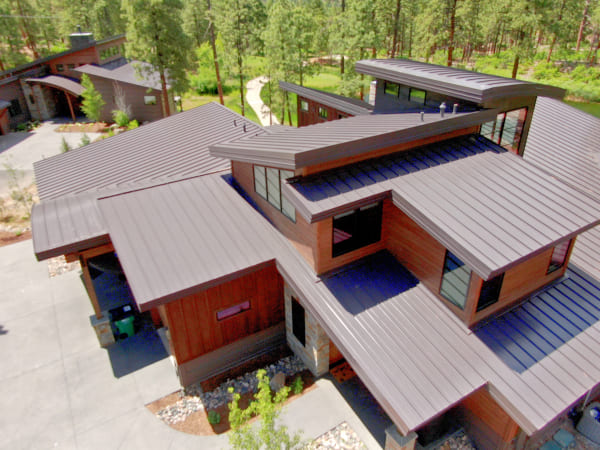Choosing the right roofing material is a significant decision for homeowners in Durango, Colorado, where the climate can be challenging with heavy snowfall, occasional hailstorms, and intense sunlight. Two popular options for residential roofing are metal roofing and traditional asphalt shingles. Each material has its own set of advantages and considerations. In this comprehensive guide, we’ll explore the key factors to help you make an informed decision when deciding between metal roofing and traditional shingles for your Durango home.
Durability and Longevity:
Metal Roofing:
Metal roofing is renowned for its exceptional durability. Most metal roofs have a lifespan of 40 to 70 years, depending on the material used. They can withstand harsh weather conditions, including heavy snow loads, hail, and high winds. Metal roofs are resistant to rot, insects, and mildew, ensuring a longer lifespan and minimal maintenance requirements.
Traditional Shingles:
Traditional asphalt shingles, while durable, have a shorter lifespan compared to metal. The average lifespan of asphalt shingles is around 20 to 30 years. They are more susceptible to damage from severe weather elements, such as hail, and may require more frequent repairs or replacements over time.
Conclusion: In terms of durability and longevity, metal roofing is the clear winner, offering a significantly longer lifespan and better resistance to environmental factors.
Aesthetics and Design Options:
Metal Roofing:
Metal roofing comes in a variety of styles and finishes, allowing homeowners to achieve a modern or traditional look. Common metal roofing styles include standing seam, metal tiles, and metal shingles. Metal roofs can be customized to complement various architectural styles, and they often have a sleek, contemporary appearance.
Traditional Shingles:
Asphalt shingles offer a traditional and classic look. They come in a wide range of colors and styles, including architectural shingles that mimic the appearance of wood shakes or slate. Asphalt shingles provide versatility and can enhance the curb appeal of homes with various design preferences.
Conclusion: The choice between metal roofing and traditional shingles in terms of aesthetics depends on personal preference. Both options offer diverse design choices to suit different styles.
Energy Efficiency:
Metal Roofing:
Metal roofing is known for its excellent energy efficiency. Many metal roofing materials have reflective coatings that bounce back the sun’s rays, reducing heat absorption. This reflective property helps keep homes cooler in the summer, leading to potential energy savings on cooling costs.
Traditional Shingles:
Asphalt shingles, while not as reflective as metal, still provide decent insulation. However, they may absorb more heat, especially in darker colors, contributing to higher temperatures in the attic and potentially increasing cooling costs.
Conclusion: Metal roofing tends to be more energy-efficient, offering better insulation and potential savings on cooling expenses.
Installation and Weight Considerations:
Metal Roofing:
Metal roofing is known for its lightweight nature, making it easier to install and reducing the structural load on the house. Installation of metal roofing can be quicker than traditional shingles, especially with the use of interlocking panels or sheets.
Traditional Shingles:
Asphalt shingles are also relatively lightweight, but they can be heavier than metal roofing materials. The weight of shingles may require additional structural support, and the installation process may take longer compared to metal roofing.
Conclusion: Metal roofing is advantageous in terms of ease of installation and reduced structural load, potentially saving on installation time and costs.
Cost Considerations:
Metal Roofing:
While the upfront cost of metal roofing is generally higher than that of traditional shingles, the long-term cost of ownership may be lower due to its extended lifespan and lower maintenance requirements. Metal roofs may also contribute to energy savings, further enhancing their overall cost-effectiveness.
Traditional Shingles:
Asphalt shingles are more budget-friendly in terms of initial costs. However, their shorter lifespan may result in higher long-term costs due to the need for more frequent replacements and repairs.
Conclusion: While metal roofing may have a higher upfront cost, it often provides better long-term value and cost savings over the life of the roof.
Maintenance and Repairs:
Metal Roofing:
Metal roofs generally require minimal maintenance. They are resistant to common issues like rot, insects, and mildew. Periodic inspections are recommended to ensure that fasteners are secure, and any potential issues are addressed promptly. Repairs, when needed, are often straightforward.
Traditional Shingles:
Asphalt shingles may require more maintenance over time. They can be susceptible to algae growth, moss, and damage from severe weather. Regular inspections and prompt repairs are essential to extend the lifespan of asphalt shingle roofs.
Conclusion: Metal roofing typically demands less maintenance, making it a more convenient option for homeowners.
Environmental Impact:
Metal Roofing:
Metal roofing is environmentally friendly and recyclable. Most metal roofing materials are made with a significant percentage of recycled content, and they can be fully recycled at the end of their lifespan. Additionally, the reflective properties of metal roofing contribute to energy efficiency.
Traditional Shingles:
Asphalt shingles are less environmentally friendly than metal roofing. They are made from petroleum-based materials and contribute to landfill waste when replaced. Some asphalt shingles are recyclable, but the recycling process may not be as efficient as that of metal.
Conclusion: Metal roofing is a more sustainable and eco-friendly option, offering better recyclability and energy efficiency.
Conclusion: Making the Right Choice for Your Durango Home
Choosing between metal roofing and traditional shingles for your Durango home involves weighing various factors, including durability, aesthetics, energy efficiency, installation, cost, maintenance, and environmental impact. While both options have their advantages, metal roofing stands out as a durable, energy-efficient, and environmentally friendly choice with a longer lifespan and lower long-term costs. Traditional shingles may be a suitable option for those on a tighter budget or those who prefer a more traditional aesthetic.
Ultimately, the right choice depends on your priorities, budget, and personal preferences. Consulting with a reputable roofing contractor in Durango can provide valuable insights and help you make an informed decision based on your specific needs and the unique requirements of your home in this picturesque Colorado town.




